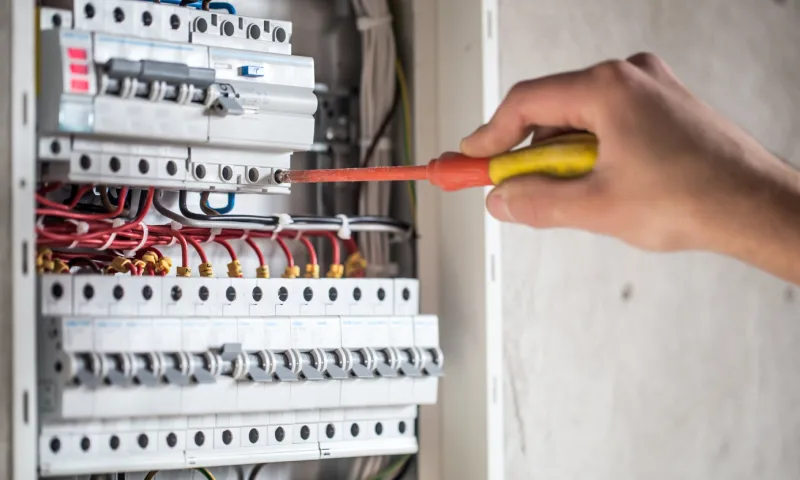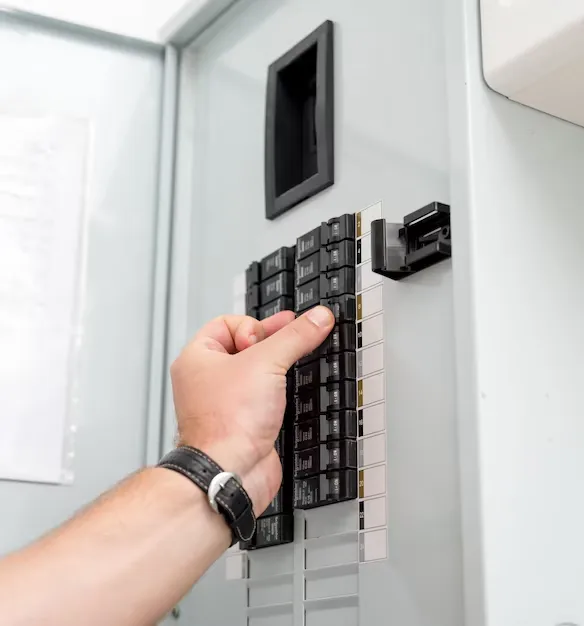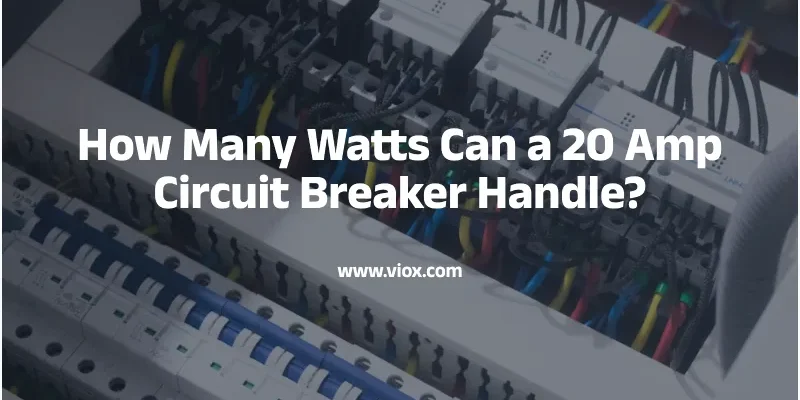20 amperų automatinio jungiklio galios supratimas yra labai svarbus elektros saugumui ir efektyviam energijos valdymui namuose. Nesvarbu, ar planuojate virtuvės renovaciją, įrenginėjate namų biurą, ar sprendžiate elektros problemas, žinodami savo grandinės apribojimus galite išvengti pavojingų perkrovų ir brangiai kainuojančių elektros problemų.
Greitas atsakymas: 20 amperų grandinės pertraukiklio galia
20 amperų automatinis jungiklis gali atlaikyti:
- Maksimali galia 2400 vatų 120 V grandinėje
- Maksimali galia 4800 vatų 240 V grandinėje
- Nuolatinėms apkrovoms rekomenduojama 1920 vatų (80% taisyklė)

Elektros pagrindų supratimas: amperai, vatai ir voltai
Esminė elektros formulė
Srovės stiprumo, galios ir įtampos santykis atitinka Omo dėsnį:
Galia (vatais) = srovė (amperais) × įtampa (voltais)
Ši pagrindinė formulė nustato, kiek elektros energijos jūsų 20 amperų jungiklis gali saugiai tiekti:
| Įtampa | Maksimali galia vatais | Rekomenduojama nuolatinė galia vatais |
|---|---|---|
| 120V | 2400 W | 1920 W |
| 208 V | 4160 W | 3 328 W |
| 220V | 4400 W | 3 520 W |
| 240V | 4800 W | 3840 W |
Kodėl įtampa svarbi skaičiuojant galią
Skirtingos buitinės grandinės veikia esant skirtingoms įtampoms:
120 V grandinės (standartinis namų ūkis)
- Miegamojo lizdai
- Svetainės indaplovės
- Dauguma apšvietimo grandinių
- Maži prietaisai
240 V grandinės (didelės galios taikymas)
- Elektrinės džiovyklės
- Centrinis oro kondicionierius
- Elektriniai vandens šildytuvai
- Elektromobilių įkrovikliai
Kaip veikia 20 amperų grandinės pertraukikliai: paaiškinti saugos mechanizmai
Šiluminė-magnetinė apsauga
Šiuolaikiniai 20 amperų automatiniai jungikliai naudoja sudėtingus apsaugos mechanizmus:
Šiluminė apsauga:
- Bimetalinė juostelė įkaista dėl ilgalaikio perkrovimo
- Išjungia automatinį jungiklį, kai srovė ilgą laiką viršija 20 amperų
- Apsaugo nuo ilgalaikių viršsrovės sąlygų
Magnetinė apsauga:
- Elektromagnetas reaguoja į staigius srovės šuolius
- Akimirksniu išsijungia trumpojo jungimo metu
- Apsaugo nuo pavojingų gedimų sąlygų
Kelionės kreivės ir atsako laikas
20 amperų jungikliai atitinka konkrečias išjungimo kreives:
- 125% apkrova (25 amperai): gali suveikti per 1–3 valandas
- 200% apkrova (40 amperų): Išjungia per 1–40 sekundžių
- Trumpojo jungimo sąlygos: suveikimai per 1–3 ciklus (0,017–0,05 sekundės)
80% taisyklė: kodėl neturėtumėte naudoti viso pajėgumo
Nacionalinio elektros kodekso (NEC) reikalavimai
NEC įpareigoja 80% mažinimo taisyklę nuolatinėms apkrovoms:
Nuolatinės apkrovos apibrėžimas:
Bet kokia apkrova, kuri, kaip tikimasi, veiks 3 valandas ar ilgiau
Pavyzdžiai: apšvietimas, šaldytuvai, ŠVOK sistemos
Skaičiavimas:
20 amperų × 0,80 = 16 amperų maksimali nuolatinė srovė
16 amperų × 120 V = 1920 vatų nuolatinė galia
Saugos ribos ir šilumos išsklaidymas
80% taisyklė neleidžia:
- Per didelis šilumos kaupimasis elektriniuose komponentuose
- Priešlaikinis jungiklio senėjimas
- Izoliacijos degradacija
- Gaisro pavojus dėl perkaitusių laidų
Išsamūs apkrovos skaičiavimo metodai
Žingsnis po žingsnio apkrovos vertinimas
- Prijungtų įrenginių inventorius
Sukurkite išsamų visų grandinėje esančių įrenginių sąrašą:
| Įrenginio tipas | Tipinė galia | Kiekis | Bendra galia vatais |
|---|---|---|---|
| LED lemputės | 8–12 W | 6 | 60 W |
| Lubų ventiliatorius | 30–75 W | 1 | 150 W |
| Stalinis kompiuteris | 300–500 W | 1 | 400 W |
| Monitorius | 30–150 W | 2 | 200 W |
| Mikrobangų krosnelė | 700–1200 W | 1 | 1000W |
- Pradinių šuolių sąskaita
Daugelis įrenginių paleidimo metu sunaudoja didesnę srovę:
- Šaldytuvo kompresorius: 3–5 kartus didesnė nei darbinė srovė
- Mikrobangų magnetronas: 2–3 kartus didesnė nei darbinė srovė
- LED valdikliai: 1,5–2 kartus didesnė nei pastovi srovė
- Taikyti įvairovės veiksnius
Ne visi įrenginiai veikia vienu metu:
- Gyvenamųjų patalpų apšvietimas: 0,75 įvairovės koeficientas
- Maži prietaisai: 0,50 įvairovės koeficientas
- Elektronika: 0,80 įvairovės koeficientas
Išplėstinio skaičiavimo pavyzdys
Virtuvės grandinės analizė:
Mikrobangų krosnelė (1000 W) + Kavos virimo aparatas (800 W) + Skrudintuvas (1200 W) = 3000 W
Didžiausia paklausa viršija 2400 W galią
Sprendimas: paskirstyti apkrovą išskirstant dalis

Įprasti buitiniai prietaisai: galios vadovas
Virtuvės prietaisai
- Mikrobangų krosnelė: 700–1200 W
- Kavos virimo aparatas: 600–1200 W
- Skrudintuvas: 800–1500 W
- Maišytuvas: 300–1000 W
- Elektrinis virdulys: 1000–1500 W
- Ryžių viryklė: 300–700 W
- Maisto smulkintuvas: 400–800 W
Namų biuro įranga
- Stalinis kompiuteris: 300–500 W
- Žaidimų kompiuteris: 500–800 W
- Lazerinis spausdintuvas: 600–1200 W (spausdinimas)
- Keli monitoriai: iš viso 100–300 W
- Maršrutizatorius / modemas: 10–50 W
Šildymas ir vėsinimas
- Šildytuvas: 1000–1500 W
- Langų oro kondicionierius: 500–1200 W
- Lubų ventiliatorius: 30–75 W
- Elektrinė grindjuostė: 250 W pėdai
Grandinės pertraukiklių tipai ir pritaikymas
Standartiniai termomagnetiniai jungikliai
Dažniausiai naudojamas gyvenamosiose patalpose, tinka bendram apšvietimui ir kištukinių lizdų grandinėms. Ekonomiškas ir patikimas.
GFCI grandinės pertraukikliai
Reikalingas drėgnose vietose (vonios kambariuose, virtuvėse, garažuose) apsaugai nuo įžeminimo gedimų. Įtampos kritimas šiek tiek didesnis nei standartinių jungiklių.
AFCI grandinės pertraukikliai
Pagal naujausius NEC reikalavimus, daugumoje gyvenamųjų patalpų privaloma naudoti lanko trumpojo jungimo grandinės pertraukiklio technologiją, kuri aptinka pavojingas lanko sąlygas.
Išmanieji grandinės pertraukikliai
Realaus laiko apkrovos stebėjimas, nuotolinio perjungimo galimybės, energijos suvartojimo stebėjimas, nuspėjamieji techninės priežiūros įspėjimai.
Įrengimo ir elektros instaliacijos ypatumai
Vielos gabarito reikalavimai
20 amperų grandinėms:
- Mažiausiai: 12 AWG varinis laidas
- Rekomenduojama: 12 AWG THWN-2 varis
- Aliuminis: 10 AWG (su tinkamomis jungtimis)
Vamzdynas ir apsauga
- EMT (elektriniai metaliniai vamzdžiai)
- PVC vamzdis požeminiams vamzdžiams
- Tinkamas įžeminimas ir sujungimas
- GFCI apsauga ten, kur reikia
Skydinės erdvės ir šilumos valdymas
- Palikite pakankamą atstumą tarp jungiklių
- Užtikrinkite tinkamą vėdinimą
- Apsvarstykite plokščių apkrovos skaičiavimus
- Būsimo plėtros planas
20 amperų grandinės problemų šalinimas
Dažnos išjungimo problemos
Diagnostiniai žingsniai:
- Apkrovos įvertinimas: apskaičiuokite bendrą prijungtą apkrovą
- Įrenginių testavimas: patikrinkite atskirus prietaisus dėl gedimų
- Laidų patikra: patikrinkite, ar nėra atsilaisvinusių jungčių
- Jungiklio bandymas: patikrinkite jungiklio veikimą
Dažnos priežastys:
- Perkrauta grandinė (viršija 20 amperų talpą)
- Sugedę prietaisai, naudojantys per didelę srovę
- Atsilaisvinusios vielos jungtys, sukeliančios kibirkštį
- Pažeista laidų izoliacija
- Senstantys jungiklio komponentai
Įtampos kritimo problemos
Simptomai:
- Pritemdykite šviesas, kai įjungiami prietaisai
- Prietaisai, veikiantys žemiau vardinio našumo
- Perkaitimo įranga
Sprendimai:
- Patobulinkite vielos gabaritą ilgiems darbams
- Sumažinkite grandinės ilgį
- Subalansuokite apkrovas keliose grandinėse
- Patikrinkite ryšio vientisumą
Elektros energijos kokybės problemos
Harmoninis iškraipymas:
Dėl elektroninių apkrovų (kompiuterių, LED tvarkyklių) gali perkaisti neutralė, todėl gali prireikti K klasės transformatorių.
Galios koeficiento korekcija:
Svarbu variklių apkrovoms, kondensatoriai gali pagerinti efektyvumą ir sumažinti matomą galios suvartojimą.
Kodekso atitiktis ir saugos standartai
Nacionalinio elektros kodekso (NEC) reikalavimai
210 straipsnis. Atšakos:
- Maksimalios apkrovos apribojimai
- Reikalavimai lizdams ir kištukiniams lizdams
- GFCI ir AFCI apsaugos taisyklės
240 straipsnis. Apsauga nuo viršsrovės:
- Jungiklio dydžio reikalavimai
- Koordinavimas su laidininko srove
- Specialios taikymo sritys ir išimtys
Vietinio kodo variantai
Visada patikrinkite vietinius leidimų pakeitimų reikalavimus, susijusius su grandinės priedų patikros procedūromis ir tvarkaraščiais.
Tarptautiniai standartai
- IEC 60947 (Tarptautiniai automatinių jungiklių standartai)
- UL 489 (JAV saugos standartas)
- CSA C22.2 (Kanados reikalavimai)
Energijos vartojimo efektyvumo ir sąnaudų aspektai
Elektros energijos sąnaudų skaičiavimas
Mėnesinių išlaidų formulė:
(Vatai ÷ 1000) × Sunaudotos valandos × Dienos × Įkainis už kWh
Pavyzdys:
1500 W šildytuvas, naudojamas 8 valandas per dieną 30 dienų, elektros energijos tarifas: $0,12/kWh
Kaina: (1500 ÷ 1000) × 8 × 30 × $0,12 = $43,20/mėn.
Apkrovos valdymo strategijos
Naudojimo laiko optimizavimas:
- Didelės galios prietaisų naudojimą planuokite ne piko valandomis
- Naudokite programuojamus laikmačius
- Įdiegti išmaniųjų namų automatizavimą
Energiją taupančios alternatyvos:
- LED apšvietimas (75% energijos taupymas)
- „ENERGY STAR“ prietaisai
- Kintamo greičio varikliai
- Išmanieji maitinimo šaltiniai
Kada atnaujinti elektros sistemą
Ženklai, kad jums reikia grandinės papildymų
Raudonos vėliavėlės:
- Dažni automatinių jungiklių išsijungimai
- Priklausomybė nuo ilgintuvo
- Lizdai, kuriuos dalijasi keli ilgintuvai
- Degimo kvapai iš elektros skydinių
- Mirksinčios lemputės prietaiso paleidimo metu
Profesinio vertinimo rodikliai
Kreipkitės į elektriką, kai:
- Pridedami pagrindiniai buitiniai prietaisai
- Namo priestatų planavimas
- Patiriant elektros gedimus
- Elektromobilių įkroviklių įrengimas
- Skydelio talpos didinimas
Sąnaudų ir naudos analizė
Papildomos grandinės išlaidos:
- Nauja 20 amperų grandinė: $300-800
- Skydo atnaujinimas: $1 500–3 500
- Viso namo elektros instaliacijos atnaujinimas: $8,000-15,000
Privalumai:
- Pagerintas saugumas
- Padidėjusi būsto vertė
- Geresnis prietaiso veikimas
- Kodekso atitiktis
Išplėstinės programos ir specialūs atvejai
Elektromobilių įkrovimas
1 lygio įkrovimas (120 V):
Galima naudoti esamą 20 amperų grandinę, įkrovimo atstumas – 3–5 mylios per valandą, tinkantis įkraunamiems hibridams.
2 lygio įkrovimas (240 V):
Reikalinga speciali 40–50 amperų grandinė. Visiškai elektromobiliams rekomenduojamas 40–64 km/h įkrovimas.
Namų dirbtuvių grandinės
Įrankio galios reikalavimai:
- Stalinis pjūklas: 1500–3000 W
- Oro kompresorius: 1000–2000 W
- Suvirinimo aparatas: 3000–8000 W
- Dulkių surinkėjas: 1000–1500 W
Grandinės planavimas:
- Specialios grandinės didelės galios įrankiams
- 240 V grandinės didelėms įrangoms
- Tinkamas įžeminimas saugumui užtikrinti
Atsinaujinančios energijos integracija
Saulės baterijų aspektai:
- Inverterio apkrovos elektros sistemoje
- Grynojo matavimo reikalavimai
- Atjungimo jungiklio vieta
Baterijų atsarginės sistemos:
- Kritinės apkrovos skydai
- Perjungimo jungiklio reikalavimai
- Apkrovos prioritetizavimas
Dažnai užduodami klausimai
Ar galiu 15 amperų automatinį jungiklį pakeisti 20 amperų automatiniu?
Ne, ne be laidų atnaujinimo. 15 amperų grandinėje naudojamas 14 AWG laidas, kuris skirtas tik 15 amperų srovei. Įrengus 20 amperų jungiklį ant 14 AWG laido, kyla gaisro pavojus, nes jungiklis neapsaugos laido nuo perkaitimo.
Kaip apskaičiuoti, ar mano prietaisai perkraus 20 amperų grandinę?
Sudėkite visų vienu metu veikiančių prietaisų galią ir padalykite gautą sumą iš grandinės įtampos:
Bendra galia vatais ÷ 120 V = Bendra amperų srovė
Nuolatinėms apkrovoms rezultatą palaikykite mažesnį nei 16 amperų, o nenuolatinėms apkrovoms – mažesnį nei 20 amperų.
Kuo skiriasi 20 amperų vienpolis ir dvipolis jungiklis?
Vienpolis: 120 V, daugiausia 2400 W, naudojamas standartinėms buitinėms grandinėms. Dvipolis: 240 V, daugiausia 4800 W, naudojamas dideliems prietaisams, pavyzdžiui, džiovyklėms ir oro kondicionieriams.
Ar LED lemputės gali sukelti 20 amperų jungiklio suveikimą?
Retai dėl viršsrovės, bet įmanoma dėl:
- Įjungimo srovė iš daugybės LED tvarkyklių
- Harmoninis iškraipymas, turintis įtakos grandinės apsaugai
- Sugedę LED valdikliai sukelia gedimų sąlygas
Kaip dažnai reikia keisti automatinius jungiklius?
Įprastas tarnavimo laikas: 25–40 metų esant įprastam naudojimui. Pakeiskite, kai:
- Dažnas nemalonus užstrigimas
- Nepavyksta tinkamai nustatyti iš naujo
- Rodo perkaitimo požymius
- Atliekant didelius elektros energijos atnaujinimus
Ar saugu nedelsiant atstatyti suveikusį 20 amperų automatinį jungiklį?
Tik nustačius ir pašalinus priežastį. Pakartotinis suveikusio jungiklio atstatymas neišsprendžiant pagrindinės problemos gali:
- Sugadinti elektros įrangą
- Sukurti gaisro pavojų
- Nurodo rimtus elektros gedimus
Išvada: maksimaliai padidinkite 20 amperų grandinės saugumą ir efektyvumą
20 amperų automatinis jungiklis standartinėse 120 V buitinėse grandinėse užtikrina 2400 vatų galią, o rekomenduojama nuolatinė apkrova pagal 80% taisyklę yra 1920 vatų. Šių apribojimų supratimas, tinkami apkrovos skaičiavimai ir saugos praktika užtikrina, kad jūsų elektros sistema veiktų efektyviai ir saugiai.
Svarbiausios išvados namų savininkams:
- Prieš prijungdami naujus prietaisus, visada apskaičiuokite bendrą apkrovą
- Nuolatinėms apkrovoms vadovaukitės 80% taisykle.
- Atnaujinkite grandines, kai artėjate prie pajėgumų ribų
- Dėl sudėtingų instaliacijų kreipkitės į licencijuotus elektrikus
- Priimdami sprendimus dėl elektros prietaisų, pirmenybę teikite saugumui, o ne patogumui.
Reguliarus elektros apkrovų vertinimas, tinkamas grandinės planavimas ir profesionali konsultacija, kai reikia, užtikrins, kad jūsų namų elektros sistema daugelį metų veiktų saugiai ir efektyviai. Kilus abejonių dėl elektros galios ar saugumo, visada pasitarkite su kvalifikuotu elektriku, kuris gali pateikti individualias rekomendacijas, atsižvelgdamas į jūsų konkrečią situaciją ir vietinius elektros kodeksus.
Susijęs
10 didžiausių MCB gamintojų, dominuojančių pasaulinėje rinkoje 2025 m.


